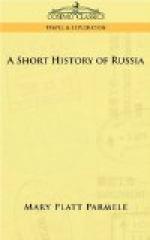The man who was to make the first breach in the walls was the grandson of Mikhail Romanoff—Peter, known as “The Great.” But the mills of the gods grind slowly—especially when they have a great work in hand; and there were to be three colorless reigns before the coming of the Liberator in 1689—seventy-six years before they would learn that to have a savage despot seated on a barbaric throne, with crown and robes incrusted with jewels, and terrorizing a brutish, ignorant, and barbaric people—was not to be Great.
The reigns of Mikhail and of his son Alexis and his grandson Feodor were to be reigns of preparation and reform. Of course there were turbulent uprisings and foreign wars, and perils on the frontiers near the Baltic and the Black seas. But Russia was gaining in ascendency while Poland, from whom she had narrowly escaped, was fast declining. The European rulers began to see advantages for themselves from Russian alliances. Gustavus Adolphus, King of Sweden and champion of Protestantism, made an eloquent appeal to the Tsar to join him against Catholic Poland—“Was not the Romish Church their common enemy?—and were they not neighbors?—and when your neighbor’s house is afire, is it not the part of wisdom and prudence to help to put it out?” Poland suffered a serious blow when a large body of Cossacks, who were her vassals, and her chief arm of defense in the Southeast, in 1681 transferred themselves bodily to Russia.
The Cossacks were a Slavonic people, with no doubt a plentiful infusion of Asiatic blood, and their name in the Tatar language meant Freebooters. They had long dwelt about the Don and the Dnieper, in what is known as Little Russia, a free and rugged community which was recruited by Russians after the Tatar invasion and Polish conquest, by oppressed peasants after the creation of serfdom, and by adventurers and fugitives from justice at all times. It was a military organization, and its Constitution was a pure democracy. Freedom and independence were their first necessity. Their Hetman, or chief, held office for one year only, and anyone might attain to that position. Their horsemanship was unrivaled—they were fearless and enduring, and stood ready to sell their services to the Khan of Tatary, the King of Poland, or to the Tsar of Russia. In fact, they were the Northmen of the South and East, and are now—the Rough-Riders of Russia.
They had long ago divided into two bands, the “Cossacks of the Dnieper,” loosely bound to Poland, and the “Cossacks of the Don,” owning the sovereignty of Russia. The services of these fearless adventurers were invaluable as a protection from Turks and Tatars; and, as we have seen in the matter of Siberia, they sometimes brought back prizes which offset their misdoings. The King of Poland unwisely attempted to proselyte his Cossacks of the Dnieper, sent Jesuit missionaries among them, and then concluded to break their spirit by severities and make of them obedient loyal Catholic subjects. He might as well have tried to chain the winds. They offered to the Tsar their allegiance in return for his protection, and in 1681 all of the Cossacks, of the Dnieper as well as the Don, were gathered under Russian sovereignty. It was this event which, in the long struggle with Poland, turned the scales at last in favor of Russia.




